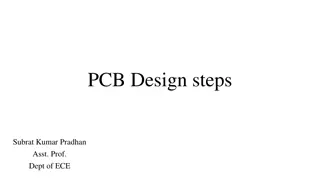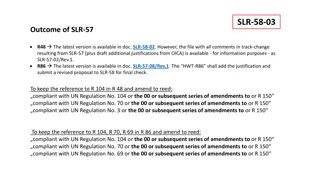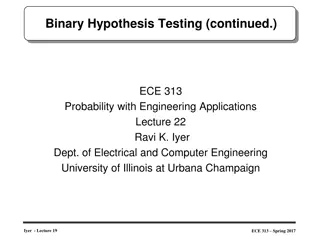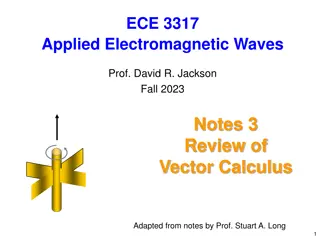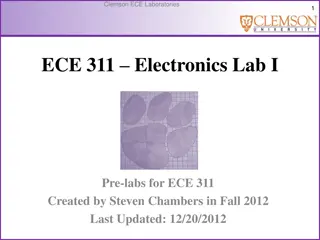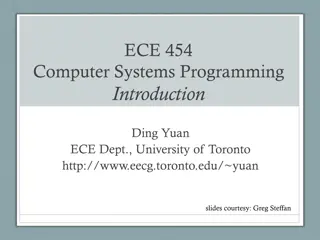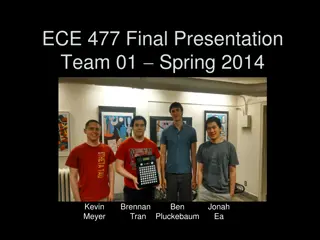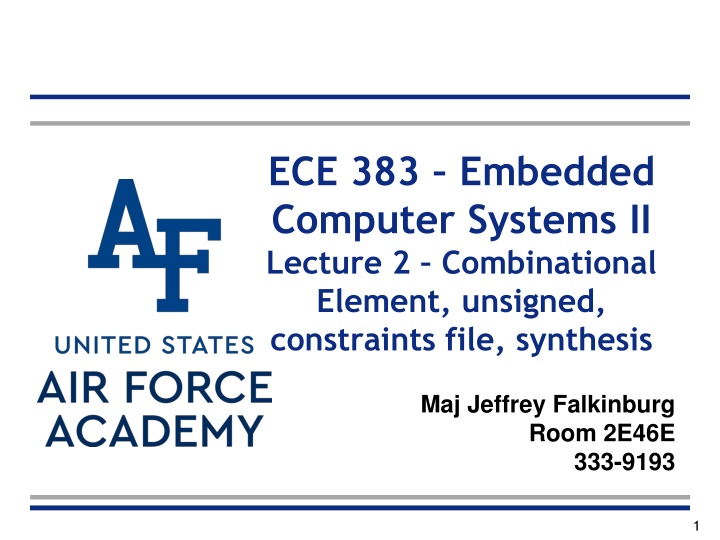
Embedded Computer Systems II Lecture on Combinational Elements and Synthesis
Explore the lecture on combinational elements, unsigned numeric standards, constraints files, and synthesis in embedded computer systems. Learn about implementing code into XDC files, constraints files, and common errors in designs. Get insights into synthesis and constraints for efficient system design.
Download Presentation

Please find below an Image/Link to download the presentation.
The content on the website is provided AS IS for your information and personal use only. It may not be sold, licensed, or shared on other websites without obtaining consent from the author. If you encounter any issues during the download, it is possible that the publisher has removed the file from their server.
You are allowed to download the files provided on this website for personal or commercial use, subject to the condition that they are used lawfully. All files are the property of their respective owners.
The content on the website is provided AS IS for your information and personal use only. It may not be sold, licensed, or shared on other websites without obtaining consent from the author.
E N D
Presentation Transcript
ECE 383 Embedded Computer Systems II Lecture 2 Combinational Element, unsigned, constraints file, synthesis Maj Jeffrey Falkinburg Room 2E46E 333-9193 1
Lesson Outline 1. Synthesis 2. Constraints file 3. Combinational Element 4. Unsigned Numeric Standard 5. Combinations 2 I n t e g r i t y - S e r v i c e - E x c e l l e n c e
pp 80 https://www.xilinx.com/support/documentation/user_guides/ug475_7Series_Pkg_Pinout.pdf 3 I n t e g r i t y - S e r v i c e - E x c e l l e n c e 21 April 2025
Synthesis 4 I n t e g r i t y - S e r v i c e - E x c e l l e n c e
Synthesis Insert this code into your Majority.xdc file Inputs from switches and outputs to LEDs # This is slide switch SW0 set_property -dict { PACKAGE_PIN E22 IOSTANDARD LVCMOS12 } [get_ports { a }]; #IO_L22P_T3_16 Sch=sw[0] # This is slide switch SW1 set_property -dict { PACKAGE_PIN F21 IOSTANDARD LVCMOS12 } [get_ports { b }]; #IO_25_16 Sch=sw[1] # This is slide switch SW2 set_property -dict { PACKAGE_PIN G21 IOSTANDARD LVCMOS12 } [get_ports { c }]; #IO_L24P_T3_16 Sch=sw[2] # This is LED Led(0) set_property -dict { PACKAGE_PIN T14 IOSTANDARD LVCMOS25 } [get_ports { f }]; #IO_L15P_T2_DQS_13 Sch=led[0] Xilix Chip UUT: Majority E22 F21 G21 a b c T14 f 5 I n t e g r i t y - S e r v i c e - E x c e l l e n c e
Constraints file 6 I n t e g r i t y - S e r v i c e - E x c e l l e n c e
Constraints file Nexyx Video Master XDC http://ece.ninja/383/datasheets/NexysVideo_Master.xdc 7 I n t e g r i t y - S e r v i c e - E x c e l l e n c e
Combinational Element 8 I n t e g r i t y - S e r v i c e - E x c e l l e n c e
Combinational Element Common error Common error that may come up in your designs You cannot use a variable listed on the entity as an out port, on the right hand side of a signal assignment statement. entity circuit is port (clk, data: in std_logic; q, not_q: out std_logic); end circuit; architecture error of circuit is begin q <= some cool logical stuff using clk and data; not_q <= not q; end error; 9 I n t e g r i t y - S e r v i c e - E x c e l l e n c e
Combinational Element Solution Solution assign "some cool logical stuff using clk and data" to a temporary variable entity circuit is port (clk, data: in std_logic; q, not_q: out std_logic); end circuit; architecture error of circuit is signal temp std_logic; begin temp <= some cool logical stuf using clk and data; q <= temp; not_q <= not temp; end error; 10 I n t e g r i t y - S e r v i c e - E x c e l l e n c e
Combinational Element - Mux Simplify muxes using conditional signal assignment statement Example: x <= y0 when S = "00" else y1 when S = "01" else y2 when S = "10" else y3; Draw this Circuit assuming 8-bit inputs Now build 4-1 mux w/ 2-1 muxes 11 I n t e g r i t y - S e r v i c e - E x c e l l e n c e
Unsigned Numeric Standard 12 I n t e g r i t y - S e r v i c e - E x c e l l e n c e
Unsigned Numeric Standard So far we mostly used STD_LOGIC_1164 library library IEEE; use IEEE.STD_LOGIC_1164.all; Library Contents: http://www.csee.umbc.edu/portal/help/VHDL/packages/std _logic_1164.vhd 13 I n t e g r i t y - S e r v i c e - E x c e l l e n c e
Unsigned Numeric Standard Numeric_Std Library supports 2 main datatypes Signed and Unsigned Library Contents: http://www.csee.umbc.edu/portal/help/VHDL/packages/nu meric_std.vhd library IEEE; use IEEE.std_logic_1164.all; use IEEE.NUMERIC_STD.ALL; entity lec3 is port( au, bu: in unsigned(3 downto 0); cu,du,su: out unsigned(3 downto 0); as, bs: in signed(3 downto 0); cs,ds,ss: out signed(3 downto 0)); end lec3; 14 I n t e g r i t y - S e r v i c e - E x c e l l e n c e
Unsigned Numeric Standard architecture structure of lec3 is begin cu <= su <= au + bu; du <= au - bu; cs <= ss <= as + bs; ds <= as - bs; "1000" when (au > bu) else "0110" when (au = bu) else "0001"; "1000" when (as > bs) else "0110" when (as = bs) else "0001"; 15 I n t e g r i t y - S e r v i c e - E x c e l l e n c e
Unsigned Numeric Standard Unsigned A B Value A Value B A >? B A =? B A <? B A + B A - B 0100 0010 0001 1011 1010 0110 1000 0111 Signed A B Value A Value B A >? B A =? B A <? B A + B A - B 0100 0010 0001 1011 1010 0110 1000 0111 16 I n t e g r i t y - S e r v i c e - E x c e l l e n c e
Unsigned Numeric Standard 17 I n t e g r i t y - S e r v i c e - E x c e l l e n c e
Unsigned Numeric Standard You will typically use STD_LOGIC_VECTOR and UNSIGNED You may need to convert between the two a: std_logic_vector(7 downto 0); b: unsigned(7 downto 0); c: std_logic_vector(7 downto 0); Lecture 4 Sequential Element b <= unsigned(a); c <= std_logic_vector(b); 18 I n t e g r i t y - S e r v i c e - E x c e l l e n c e
Combinations 19 I n t e g r i t y - S e r v i c e - E x c e l l e n c e
Combinations Common Combinations if/then/else All conditional statements consist of three parts: the condition to be checked (the if clause) the statement to be evaluated when the condition is true (the then clause) the statement to be evaluated when the condition is false (the else clause) Typically, the condition being evaluated seeks the relative magnitude of two unsigned binary numbers, requiring a comparator. The then and else clauses will typically require some logic or arithmetic operation 20 I n t e g r i t y - S e r v i c e - E x c e l l e n c e
Combinations In order to illustrate the hardware realization of a conditional statement, consider the following example: C: if (a<4) then z=y+3 else z=y+7 VHDL: z <= y+3 when (a < 4) else y+7; 21 I n t e g r i t y - S e r v i c e - E x c e l l e n c e
Combinations However, this circuit is not minimal, one of the adders can be removed. How? Practice on Homework 22 I n t e g r i t y - S e r v i c e - E x c e l l e n c e
Lesson Outline 1. Synthesis 2. Constraints file 3. Combinational Element 4. Unsigned Numeric Standard 5. Combinations 23 I n t e g r i t y - S e r v i c e - E x c e l l e n c e


